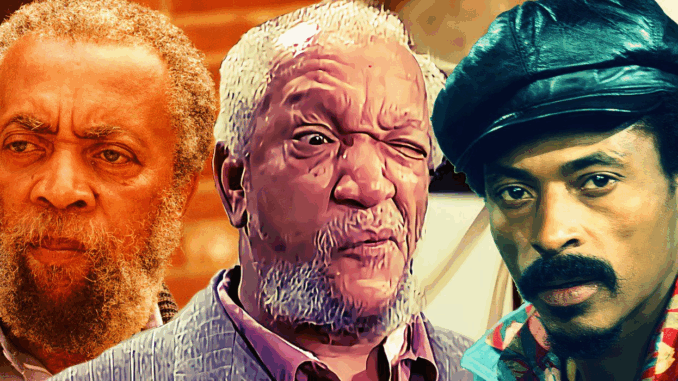
In the cluttered, chaotic world of the Sanford and Son junkyard, where insults flew as fast as Fred Sanford could fake a heart attack, there was one presence who could bring an entirely different, jittery energy: Grady Wilson. Played with masterful comedic timing by Whitman Mayo, Grady was far more than just Fred’s best friend; he was an accidental star whose role was initially meant to be a one-time guest appearance. Yet, Mayo’s unforgettable performance resonated so deeply with audiences that he was written into the fabric of the show, earning him a long, successful career that spanned three decades and included an unexpected transition into academia.
From One-Shot to Staple: The Birth of Grady
Whitman Mayo’s journey to becoming a beloved face on television was a long and unconventional one. Born in New York City in 1930, Mayo had a varied background, including serving in the U.S. Army during the Korean War, attending several colleges, and even working as a counselor for delinquent boys. Before Hollywood, he spent years honing his craft in theater, notably with the Harlem-based Lafayette Theatre.
When he finally landed an audition for Sanford and Son in 1973, it was for a minor, one-off role: Grady Wilson, Fred Sanford’s goofy, jittery pal. Mayo, who was only in his early forties at the time, modeled the character after his own grandfather, adopting a scraggly grey beard and a stooped posture that perfectly sold the illusion of a much older man.
The character was an immediate hit. Mayo’s performance—characterized by his wide-eyed innocence, his often-misguided advice, and his memorable catchphrase, “Good goobily goop!”—charmed audiences. The dynamic between the hyper-suspicious Fred and the eternally well-meaning, scatterbrained Grady provided a fresh comedic angle. The producers quickly realized they had a gem and made Grady a recurring character, effectively elevating Mayo from a guest star to a primary member of the supporting cast.
The Improbable Stardom: Grady Takes Over
The strength of Mayo’s performance was never more evident than when he was called upon to fill the massive comedic shoes of the show’s star, Redd Foxx. During Sanford and Son‘s run, Foxx had several well-publicized salary and health-related disputes that led to him briefly walking off the show.
In one of the show’s most remarkable creative pivots, Whitman Mayo’s Grady Wilson temporarily took over as the lead character, moving into the junkyard with Lamont (Demond Wilson). For a time, the show essentially became “Grady and Son.” This period, which could have tanked the series, instead proved the resilience of the supporting cast and the immense popularity of the Grady character. Ratings remained strong, proving that Whitman Mayo could carry the show’s comedic weight and successfully hold the spotlight until Fred Sanford returned.
This popularity led to the inevitable: a spinoff. In 1975, while Sanford and Son was still in production, NBC launched Grady. The show followed Grady as he moved out of Watts to live with his daughter and her family in Los Angeles. Unfortunately for Mayo, the magic of the junkyard didn’t translate well to the new setting. Without the familiar setting and, crucially, without his legendary foil, Redd Foxx, the show struggled to find its footing and was canceled after only 12 episodes. Mayo quickly returned to the original program, a testament to the fact that, in the world of sitcoms, setting and chemistry are often just as important as the star.
A Career That Escaped Grady’s Shadow
After Sanford and Son ended in 1977, Whitman Mayo found himself in the common predicament of a beloved character actor: forever associated with his iconic role. While he reprised the role of Grady in the subsequent, short-lived spinoffs Sanford Arms (1977) and Sanford (1980-1981), he consciously worked to diversify his career and escape Grady’s long shadow.
His three-decade-long career is a tribute to his versatility, featuring appearances across the spectrum of film and television:
- Television Guest Star: Mayo appeared in nearly every major television genre of the 70s, 80s, and 90s, including popular shows like Starsky and Hutch, The Main Event, Diff’rent Strokes, Hill Street Blues, In the Heat of the Night, Family Matters, Full House, and even a memorable guest turn on ER in 1999.
- Film Roles: Mayo also made his mark on the big screen, securing roles in films like D.C. Cab (1983) and, most notably, in director John Singleton’s acclaimed 1991 drama, Boyz n the Hood, where he played “The Old Man.” These roles showcased his ability to move seamlessly between comedy and serious dramatic acting, proving his range extended far beyond the junkyard.
A Legacy of Teaching and The Arts
Perhaps the most fascinating chapter of Whitman Mayo’s life was his decision to pivot from the spotlight to the classroom. In his later years, Mayo relocated to Atlanta, Georgia, and joined the faculty of Clark Atlanta University. There, he dedicated himself to teaching the next generation of performers, passing on the knowledge he had accumulated over a lifetime in the theater and television. This commitment to education underscored his passion for the arts as a whole, rather than just the fame it provided.
Mayo’s career is a testament to the enduring power of a single, well-played character. Though his spin-off didn’t last, his performance as Grady Wilson is what cemented his place in television history. He remains a cherished figure, remembered not only for the infectious laughter he brought to millions but also for the long, quiet dedication he showed to his craft, culminating in his final role as a mentor and teacher. Whitman Mayo passed away in 2001, but his legacy, much like his famous catchphrase, remains a source of pure “Good goobily goop” joy for fans everywhere.
